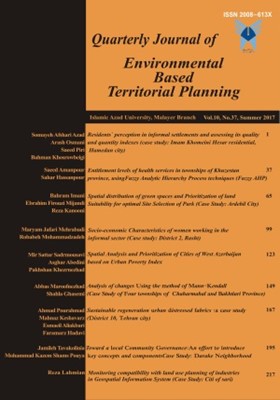Analaysis of sustainable regeneration urban distressed area, case study: (District 10, Tehran city)
Subject Areas :Faramarz Hadavi 1 , ahmad Pourahmad 2 , Mahnaz Keshavarz 3 , Esmaeil Aliakbari 4
1 - مهندسان مشاور کهن شهر
2 - Departman Geography-Tehran university
3 - Departoman Geography,Tehran
4 - Departman Geography.Payam Noor Tehran university
Keywords: Tehran, urban regeneration, unsustainability, distressed area,
Abstract :
distressed textures are regions which are separated from life evolution cycle and became the bone of problems and inefficiencies. Nevertheless, these textures account for high percentage of urban population, and yet have numerous capacities and potentials for future intra-city developments. Dealing with distressed and inefficient urban textures is not apart from dealing with economic, cultural and social realities, and entails careful, comprehensive and realistic planning. In recent years, urban regeneration has been brought up as a new approach for improvement and renovation of these textures. “Urban regeneration” approach is beyond objectives, desires and achievements of “urban renovation”, “urban development”, and “urban improvement”, and has comprehensive, consistent and sustainable outlook by considering all social, economic, physical and environmental aspects. The current study has been carried out by understanding effective factors on urban distressed textures and evaluating the sustainability and unsustainability of District 10, and using SWOT-QSPM methods; research variables were determined through documentary and library studies that include social, economic, and environmental indicators . Throughout the survey method, the required information was collected and analyzed using the entropy criterion and SWOT-QSPM model. Further quantitative results showed that this area is economically unstable in the first place due to its social and environmental dimensions. The instability of the economic dimensions of the tissue is that: this leads to the instability of the other dimensions of the texture and ultimately shows itself as a physical instability. Thus, the later approach of sustainable urban regeneration with the strategy (economic regeneration and community-based recreation), due to its integrated globalization and interactivity, can be an optimal version to intervene with this tissue.
1- پوراحمد،ا.،حبیبی،ک.،کشاورز،م. 1389. سیرتحول مفهوم شناسی بازآفرینی شهری به عنوان رویکرد نو در بافت های فرسوده شهری. فصلنامه مطالعات شهر ایرانی-اسلامی، شماره اول
2- زیویار، پ.، عظیمی، آ.، فرجی ملایی،ا. 1393. برنامه ریزی و مدیریت نوسازی و بهسازی بافت های فرسوده شهری. چاپ اول، دانشگاه آزاد اسلامی واحد یادگار امام خمینی(ره).16
3- سازمان فناوری اطلاعات و ارتباطات شهر داری تهران.1390. سالنامه آماری شهر تهران، شهرداری تهران
4- سازمان نوسازی شهر تهران.1394. مستند نگاری پروژه های شاخص شهر تهران (نوسازی بافت های فرسوده شهر تهران). چاپ اول. انتشارات شهرداری تهران
5- شرکت مادر تخصصی عمران وبهسازی شهری ایران.1393.شیوه نامه تعیین محله ها و محدوده های هدف بازآفرینی شهری و راه کارهای اجرایی آن، وزارت راه شهرسازی.8
6- کشاورز، م. 1389. سنجش و ارزیابی رویکرد توسعه پایدار و امکان کاربست آن در بازآفرینی بافت های فرسوده شهری (مطالعه موردی: شهرخرم آباد). رساله دکتری، دانشگاه تهران.19
7- فرجی مولایی، ا.1389. انواع روش های مداخله در بهسازی و نوسازی شهری. ماهنامه اطلاع رسانی،آموزشی وپژوهشی، شماره 54. 15
8- لطفی، س. 1391. تبارشناسی بازآفرینی شهری، از بازسازی تا نوزایی. چاپ اول. انتشارات آذرخش
9- مختاری ملک آبادی، ر.، ابراهیمی، م.،کرمی،آ.1394. تدوین استراتژی های راهبردی بهسازی و نوسازی بافت فرسوده شهر جهرم با استفاده از مدلSWOT. فصلنامه آمایش محیط، دوره8، شماره29، تابستان. 181-180
10- معینی فر،ف.، پاکشیر،ع.، شعله،م. حاجی پور،خ. 1392. بازآفرینی بافت های فرسوده با رویکرد مشارکت جویانه در جهت نیل به اهداف توسعه پایدار. اولین کنفرانس ملی معماری و فضاهای شهری پایدار،مشهد.
11- مفیدی،م وهمکاران؛ (1393)، رویکردها و سیاست های نوسازی شهری (از بازسازی تا بازآفرینی شهری پایدار)، فصلنامه مطالعات شهری، دانشگاه کردستان، شماره9 .22
12- نصیری، ا.1392. تحلیل ناپایداری مکانی- فضایی بافت های فرسوده شهری (مطالعه موردی منطقه 10 شهرتهران). فصلنامه مدیریت شهری،شماره31. 280-269
13- نوریان، ف.، آرایانا، ا.1391. تحلیل چگونگی حمایت قانون از مشارکت عمومی در بازآفرینی شهری. نشریه هنرهای زیبا، دوره17، شماره2. 17
14- Cheuk Man HO,Edmond,(2012),Renewing the urban regeneration approach in Hong Kong, Discovery-ss student E-journal, College of Liberal Arts and Social Sciences ,Hong Kong
15- Roberts,Peter & Sykes,Hugh(2000),Urban Regeneration(A hand book), SAGE Publications, New Delhi
16- -Couch, Chris & Dennemann , Annekatrin(2000) Urban regeneration and sustainable development in Britain ,Cities journal, Vol. 17, No. 2, pp. 137–147
17- UNDP (2004) Guidelines for urban regeneration in the Mediterranean region,Priority Actions Program Regional Activity Centre.
_||_

